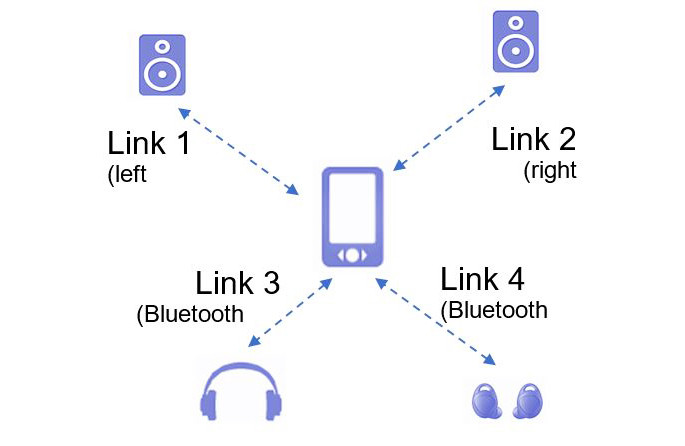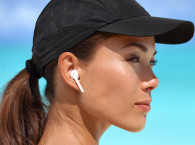
Stand-alone earbuds have to be very small and light, allowing for only tiny power sources. And while the Bluetooth A2DP profile is defined to stream audio stereo, it is still point to point, which means that the standard doesn't (yet) define a method to handle streaming to two or more physically unconnected devices, in this case wireless earbuds. (A spec over BLE is expected in 2020.) So, a number of different solutions have emerged to bridge this gap.
One class of solutions depends on a Bluetooth link to one earbud, which then forwards the other channel to the other earbud. Qualcomm TrueWireless does this using an A2DP link for forwarding. The downside is that this is not very power efficient, even if it were done over Bluetooth Low Energy (BLE), because the primary earbud has to handle two Bluetooth links. Another approach uses near-field magnetic induction (NFMI) communication for forwarding. This is more power efficient but generally viewed as bulky and expensive. NXP is a leader in this approach, which is quite well established in hearing aids.
Qualcomm has gone one better with TrueWireless Stereo Plus in which each stereo channel is handled by a separate A2DP link from the phone (or other source device). This is very power efficient and lets the phone (which has more juice than the earbuds) take care of synchronization. However, we suspect this solution is captive, requiring Qualcomm chips in the earbuds and the phone.
Another technique uses what is often seen as a threat instead of as a useful feature. Again, the point-to-point connection is from the phone to one earbud. The second earbud "eavesdrops" on this link to pick up its channel. The method is very low power and will work with any Bluetooth-enabled smartphone. However, techniques to accomplish this eavesdropping are covered by multiple patents so any solution in this area is likely to come with licensing headaches.
Yet another approach is MFi LEA, an Apple proprietary low-energy audio solution based on BLE. Again, each earbud is supported by a separate link from the phone, assuring low power consumption and synchronization managed at the phone. But this only works within the Apple ecosystem. This solution is designed particularly for accessibility (phone, music, etc.) for the hearing impaired.
So - no shortage of solutions, but buyer beware. You'd better make sure the earbuds you pick are compatible with your phone, and your other phone, and the next phone you'll get when you upgrade (these earbuds aren't cheap). And you should think about how long they'll stay charged. Going on a day hike? Battery life between charges seems to run from 3 to 5 hours, listening only, before you have to put the earbuds back in the case. Obviously better to go with the lowest power solutions.
A company called Tempow, based in Paris, France, has developed a software solution that can run on any Bluetooth chip on any smartphone, providing independent links for left and right earbuds and, hence, a very low power true wireless stereo solution for ear buds. No special hardware required on the phone. As long as the earbuds are based on a compatible classic Bluetooth BR/EDR solution, they will always work with any phone that has licensed the Tempow software. And they'll provide battery life matching the best.

There's another interesting consideration - suppose you want to support more than two speakers? Maybe stereo speakers in the room, a stereo headset, and your stereo earbuds. Tempow can do that too, for any Bluetooth speakers and headsets.
Sound good? There is still a little work underway to optimize this solution for earbuds, particularly to synchronize between left and right channels. For speakers in a room, separated by at least a meter, delays of ~10 ms between channels is not really noticeable. But with earbuds, we start to be able to detect latencies of > 25 us (corresponding to one audio sample). Fixing this takes some collaboration between the software and hardware solutions. CEVA will demonstrate a convincing solution in this direction, in partnership with Tempow, during their CEVA Technology Symposium series in Asia this year.
So yes, true stereo wireless earbuds are possible in a non-captive solution. And that's what it will take for wireless stereo to truly take off.
www.ceva-dsp.com





